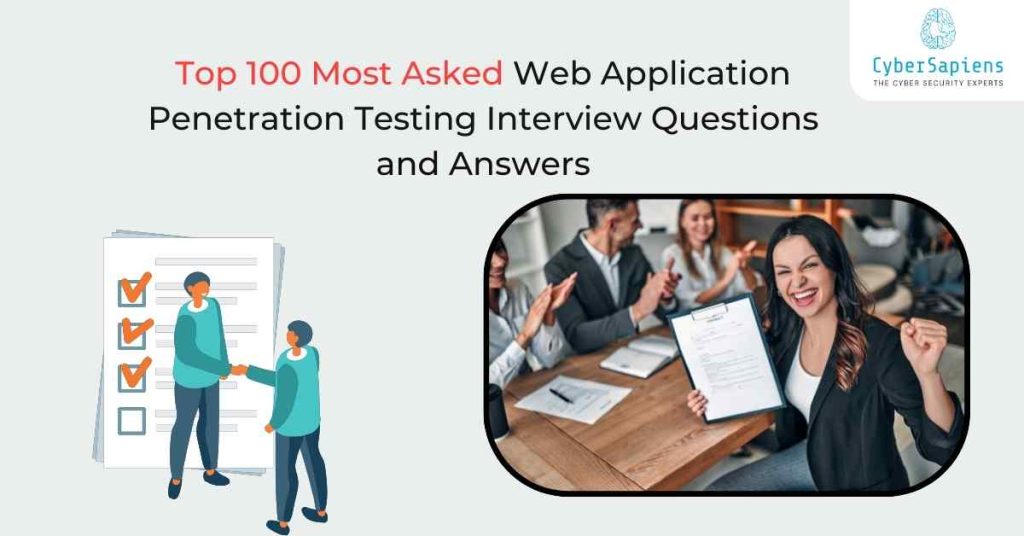In a web application penetration testing job, security is paramount. As a professional in this field, it is essential to identify weaknesses in web applications and prevent them from being exploited by hackers. With the growing demand for web application penetration testing experts, acing an interview for this role is critical.
In this article, you will learn the “Top 100 Most Asked Web Application Penetration Testing Interview Questions and Answers” for the year 2024. This article outlines the most important interview questions for security professionals and penetration testers of all experience levels.
List of Top 100 Most Asked Web Application Penetration Testing Interview Questions and Answers | Updated 2024

Here is the list of Top 100 Most Asked Web Application Penetration Testing Interview Questions and Answers | Updated 2024:
1. What is web application penetration testing?
Answer: Web application penetration testing is a simulated cyber attack against a web application to assess its security and identify vulnerabilities.
2. What is the difference between a vulnerability scan and a penetration test?
Answer: A vulnerability scan is an automated process that detects potential vulnerabilities, while a penetration test is a manual process that simulates a real-world attack to exploit vulnerabilities.
3. What is the OWASP Top 10?
Answer: The OWASP Top 10 is a list of the most critical web application security risks, published by the Open Web Application Security Project.
4. What is SQL injection?
Answer: SQL injection is a type of web application security vulnerability that allows an attacker to inject malicious SQL code to access sensitive data.
5. What is cross-site scripting (XSS)?
Answer: XSS is a type of web application security vulnerability that allows an attacker to inject malicious scripts into a website, potentially stealing user data.
6. What is the difference between HTTP and HTTPS?
Answer: HTTP is an unencrypted protocol, while HTTPS is an encrypted protocol that provides secure communication between a website and its users.

7. What is a secure socket layer (SSL)?
Answer: SSL is a cryptographic protocol that provides secure communication between a website and its users.
8. What is input validation?
Answer: Input validation is the process of checking user input data to prevent malicious code from being injected into a web application.
9. What is a web application firewall (WAF)?
Answer: A WAF is a security system that monitors and controls incoming and outgoing web traffic, protecting a web application from attacks.
10. What is a secure development life cycle (SDLC)?
Answer: SDLC is a process that integrates security practices into each stage of software development to ensure secure coding.
11. What is Burp Suite?
Answer: Burp Suite is a popular tool used for web application penetration testing, providing features such as proxying, scanning, and vulnerability identification.
12. What is ZAP (Zed Attack Proxy)?
Answer: ZAP is an open-source web application security scanner that helps identify vulnerabilities and provides detailed reports.
13. What is Nmap?
Answer: Nmap is a network discovery and security auditing tool used to scan networks and identify open ports, services, and operating systems.
14. What is Metasploit?
Answer: Metasploit is a penetration testing framework that provides a collection of exploits, payloads, and tools for simulating attacks.
15. What is Nessus?
Answer: Nessus is a vulnerability scanner that provides comprehensive reports on network vulnerabilities, configuration issues, and compliance checks.
16. What is a buffer overflow?
Answer: A buffer overflow is a type of vulnerability that occurs when more data is written to a buffer than it can hold, leading to potential code execution.
17. What is a cross-site request forgery (CSRF)?
Answer: CSRF is a type of vulnerability that allows an attacker to trick a user into performing unintended actions on a website.
18. What is a server-side request forgery (SSRF)?
Answer: SSRF is a type of vulnerability that allows an attacker to trick a server into making unauthorized requests to internal or external systems.
19. What is a file inclusion vulnerability?
Answer: A file inclusion vulnerability occurs when an application includes a file from an untrusted source, potentially leading to code execution.
20. What is a command injection vulnerability?
Answer: A command injection vulnerability occurs when an application allows an attacker to inject system commands, potentially leading to arbitrary code execution.
21. What is the OSSTMM (Open Source Security Testing Methodology Manual)?
Answer: The OSSTMM is a comprehensive methodology for security testing, providing a framework for penetration testing and vulnerability assessment.
22. What is the PTES (Penetration Testing Execution Standard)?
Answer: The PTES is a set of guidelines for penetration testing, providing a framework for conducting penetration tests and reporting vulnerabilities.
23. What is a penetration testing report?
Answer: A penetration testing report is a document that summarizes the findings and recommendations from a penetration test, providing a comprehensive overview of the identified vulnerabilities and remediation steps.
24. What are secure coding practices?
Answer: Secure coding practices involve writing code that is secure, reliable, and scalable, adhering to security guidelines and best practices.
25. What is input sanitization?
Answer: Input sanitization is the process of cleaning and sanitizing user input data to prevent malicious code from being injected into a web application.
26. What is output encoding?
Answer: Output encoding is the process of encoding data to prevent cross-site scripting (XSS) and other injection attacks.
27. What is a web application security policy?
Answer: A web application security policy is a document that outlines the security practices and guidelines for developing and maintaining secure web applications.
28. What is a threat modelling exercise?
Answer: A threat modelling exercise is a process that identifies potential threats and vulnerabilities in a web application, providing a comprehensive overview of the attack surface.
29. What is a containerization security?
Answer: Containerization security involves securing containers and container orchestration tools, such as Docker and Kubernetes.
30. What is serverless security?
Answer: Serverless security involves securing serverless computing environments, such as AWS Lambda and Azure Functions.
31. What is an API security?
Answer: API security involves securing application programming interfaces (APIs), and protecting them from unauthorized access and malicious attacks.
32. What is cloud security?
Answer: Cloud security involves securing cloud computing environments, such as AWS, Azure, and Google Cloud.
33. What is a DevSecOps?
Answer: DevSecOps is a set of practices that integrates security into DevOps, providing a culture of security and collaboration between development and security teams.
34. How would you identify a SQL injection vulnerability?
Answer: I would use a combination of manual testing and automated tools, such as Burp Suite and SQLmap, to identify potential SQL injection vulnerabilities.
35. What is your approach to penetration testing a web application?
Answer: I would follow a structured approach, including reconnaissance, mapping, and vulnerability identification, to ensure a comprehensive penetration test.
36. How do you handle a complex vulnerability that requires multiple steps to exploit?
Answer: I would break down the vulnerability into smaller components, documenting each step and potential exploitation route to ensure a clear and concise report.
37. How do you prioritize vulnerabilities in a penetration testing report?
Answer: I would prioritize vulnerabilities based on their severity, exploitability, and potential impact on the organization, ensuring that the most critical vulnerabilities are addressed first.
38. Can you walk me through a recent penetration test you conducted?
Answer: Yes, I can provide a detailed overview of a recent penetration test, including the methodology, tools, and findings.
39. How do you stay current with the latest web application security threats and trends?
Answer: I stay current through continuous learning, attending conferences, and participating in online communities and forums.
40. What is your approach to secure coding practices?
Answer: I follow best practices, such as input validation, output encoding, and secure coding guidelines, to ensure secure and reliable code.
41. How do you handle sensitive data, such as credit card numbers and passwords?
Answer: I would use secure storage mechanisms, such as encryption and hashing, to protect sensitive data.
42. Can you explain the concept of defensive programming?
Answer: Defensive programming involves writing code that is secure, reliable, and fault-tolerant, anticipating potential security threats and vulnerabilities.
43. How do you ensure secure communication between a web application and its users?
Answer: I would use secure protocols, such as HTTPS, and encryption mechanisms, such as SSL/TLS, to ensure secure communication.
44. How do you handle a zero-day vulnerability in a web application?
Answer: I would follow a structured approach, including containment, mitigation, and remediation, to handle a zero-day vulnerability.
45. What is your approach to securing microservices-based web applications?
Answer: I would follow a service-oriented architecture, securing each microservice individually, and ensuring secure communication between them.
46. Can you explain the concept of a single-page application (SPA) security?
Answer: SPA security involves securing single-page applications, which involve complex client-side logic and sensitive data, using techniques such as JavaScript encryption and token-based authentication.
47. How do you handle a web application that uses a third-party library with known vulnerabilities?
Answer: I would follow a structured approach, including vulnerability assessment, mitigation, and remediation, to handle a web application that uses a third-party library with known vulnerabilities.
48. Can you walk me through a recent web application security project you worked on?
Answer: Yes, I can provide a detailed overview of a recent web application security project, including the challenges, solutions, and outcomes.
49. What is your favourite penetration testing tool and why?
Answer: I prefer Burp Suite, as it provides a comprehensive set of features for web application penetration testing.
50. How do you use Nmap for penetration testing?
Answer: I use Nmap for network discovery, port scanning, and operating system detection to identify potential vulnerabilities.
51. Can you explain the concept of a proxy server in penetration testing?
Answer: A proxy server is used to intercept and analyze web traffic, allowing for the identification of potential vulnerabilities and sensitive data.
52. How do you handle a web application that uses anti-debugging techniques?
Answer: I would use techniques such as code obfuscation and anti-tampering to bypass anti-debugging techniques.
53. Can you walk me through a recent penetration test you conducted using Metasploit?
Answer: Yes, I can provide a detailed overview of a recent penetration test, including the exploitation routes and payloads used.
54. What is your approach to secure coding practices?
Answer: I follow best practices, such as input validation, output encoding, and secure coding guidelines, to ensure secure and reliable code.
55. How do you handle sensitive data, such as credit card numbers and passwords?
Answer: I would use secure storage mechanisms, such as encryption and hashing, to protect sensitive data.
56. Can you explain the concept of secure communication protocols?
Answer: Secure communication protocols, such as HTTPS and SSL/TLS, ensure secure communication between a web application and its users.
57. How do you ensure secure authentication and authorization mechanisms?
Answer: I would use secure authentication mechanisms, such as OAuth and OpenID, and authorization mechanisms, such as Role-Based Access Control (RBAC), to ensure secure access to web applications.
58. Can you walk me through a recent web application security project you worked on, focusing on secure coding practices?
Answer: Yes, I can provide a detailed overview of a recent web application security project, including the secure coding practices used.
59. What is the OWASP Web Application Penetration Testing Methodology?
Answer: The OWASP Web Application Penetration Testing Methodology is a comprehensive guide for penetration testing web applications, providing a framework for identifying vulnerabilities.
60. Can you explain the concept of a penetration testing report?
Answer: A penetration testing report is a document that summarizes the findings and recommendations from a penetration test, providing a comprehensive overview of the identified vulnerabilities and remediation steps.
61. How do you prioritize vulnerabilities in a penetration testing report?
Answer: I would prioritize vulnerabilities based on their severity, exploitability, and potential impact on the organization, ensuring that the most critical vulnerabilities are addressed first.
62. Can you walk me through a recent penetration test you conducted, focusing on the methodology used?
Answer: Yes, I can provide a detailed overview of a recent penetration test, including the methodology used and the findings identified.
63. What is a web application firewall (WAF)?
Answer: A WAF is a security system that monitors and controls incoming and outgoing web traffic, protecting a web application from attacks.
64. Can you explain the concept of a secure development life cycle (SDLC)?
Answer: SDLC is a process that integrates security practices into each stage of software development to ensure secure coding.
65. How do you handle a web application that uses a third-party library with known vulnerabilities?
Answer: I would follow a structured approach, including vulnerability assessment, mitigation, and remediation, to handle a web application that uses a third-party library with known vulnerabilities.
66. Can you walk me through a recent web application security project you worked on, focusing on secure coding practices and SDLC?
Answer: Yes, I can provide a detailed overview of a recent web application security project, including the secure coding practices used and the SDLC followed.
67. What is your approach to securing cloud-based web applications?
Answer: I would follow a cloud-agnostic approach, securing cloud-based web applications using cloud security best practices and technologies.
68. How do you handle a web application that uses machine learning or artificial intelligence?
Answer: I would follow a structured approach, including secure coding practices, data protection, and model validation, to ensure the secure development and deployment of machine learning or artificial intelligence-based web applications.
69. Can you explain the concept of a threat model?
Answer: A threat model is a systematic approach to identifying and mitigating potential security threats to a web application, providing a comprehensive understanding of the attack surface.
70. How do you stay current with emerging web application security threats and trends?
Answer: I stay current through continuous learning, attending industry conferences, and participating in online forums and communities, such as OWASP and SANS.
71. What is the OWASP WebGoat certification?
Answer: The OWASP WebGoat certification is a professional certification that demonstrates expertise in web application security testing and secure coding practices.
72. What is the CISSP certification?
Answer: The CISSP (Certified Information Systems Security Professional) certification is a professional certification that demonstrates expertise in information security, including web application security.
73. How do you ensure compliance with industry standards and regulations, such as PCI-DSS and HIPAA?
Answer: I ensure compliance by conducting regular security audits, implementing security controls, and providing training and awareness programs for stakeholders.
74. Can you explain the concept of a security compliance framework?
Answer: A security compliance framework is a structured approach to ensuring compliance with industry standards and regulations, providing a comprehensive framework for managing security risk.
75. What is Burp Suite?
Answer: Burp Suite is a comprehensive tool for web application penetration testing, providing features such as vulnerability scanning, crawling, and repeater.
76. What is ZAP (Zed Attack Proxy)?
Answer: ZAP is an open-source web application security scanner, that provides features such as vulnerability scanning and penetration testing.
77. How do you use Nessus for web application vulnerability scanning?
Answer: I use Nessus for identifying potential vulnerabilities in web applications, including configuration vulnerabilities and missing patches.
78. Can you explain the concept of a web application firewall (WAF)?
Answer: A WAF is a security system that monitors and controls incoming and outgoing web traffic, protecting a web application from attacks.
79. What is the biggest web application security challenge you’ve faced, and how did you overcome it?
Answer: [Provide an example of a challenging web application security project you’ve worked on, and how you overcame the challenges.]
80. How do you handle a web application with a large attack surface?
Answer: I would use a combination of security controls, such as secure coding practices, input validation, and output encoding, to reduce the attack surface.
81. Can you walk me through a recent web application security project you worked on, focusing on the challenges and solutions?
Answer: Yes, I can provide a detailed overview of a recent web application security project, including the challenges faced and the solutions implemented.
82. How do you ensure that web application security is integrated into the SDLC?
Answer: I ensure that web application security is integrated into the SDLC by providing training and awareness programs for developers, conducting regular security audits, and implementing security controls throughout the development process.
83. How do you handle a web application with a large number of users and high traffic?
Answer: I would implement scalable security controls, such as load balancing and content delivery networks (CDNs), to ensure the web application can handle high traffic and a large number of users.
84. Can you explain how to implement an incident response plan for a web application?
Answer: Yes, I can explain the steps to implement an incident response plan, including identifying incident response teams, establishing incident classification criteria, and providing incident response training and exercises.
85. How do you ensure that web application security is aligned with business objectives?
Answer: I ensure that web application security is aligned with business objectives by conducting risk assessments, identifying business-critical assets, and implementing security controls that support business objectives.
86. Can you explain the concept of a secure web application architecture?
Answer: A secure web application architecture is a design that integrates security controls and principles throughout the web application, providing a comprehensive security posture.
87. How do you design a secure web application?
Answer: I design a secure web application by following secure coding practices, implementing security controls, and integrating security principles throughout the development process.
88. What is a defence-in-depth strategy, and how does it apply to web application security?
Answer: A defence-in-depth strategy is a security approach that integrates multiple layers of security controls to prevent and detect attacks, providing a comprehensive security posture.
89. Can you explain the concept of a secure web application framework?
Answer: A secure web application framework is a structured approach to developing secure web applications, providing a comprehensive set of security controls and principles.
90. What is the difference between black box, grey box, and white box testing?
Answer: Black box testing involves testing without knowledge of the internal workings, grey box testing involves testing with partial knowledge, and white box testing involves testing with complete knowledge of the internal workings.
91. How do you conduct a web application security test?
Answer: I conduct a web application security test by identifying vulnerabilities, exploiting vulnerabilities, and providing recommendations for remediation.
92. Can you explain the concept of a web application security testing framework?
Answer: A web application security testing framework is a structured approach to testing web applications, providing a comprehensive set of testing scenarios and methodologies.
93. How do you validate the security of a web application?
Answer: I validate the security of a web application by conducting regular security audits, testing for vulnerabilities, and providing recommendations for remediation.
94. What is the OWASP Top 10, and how does it relate to web application security?
Answer: The OWASP Top 10 is a list of the top 10 web application security risks, providing a comprehensive guide to web application security.
95. Can you recommend any web application security resources, such as books or online courses?
Answer: Yes, I can recommend several web application security resources, including books, online courses, and industry conferences.
96. How do you stay current with emerging web application security threats and trends?
Answer: I stay current through continuous learning, attending industry conferences, and participating in online forums and communities, such as OWASP and SANS.
97. Can you provide an example of a web application security best practice?
Answer: Yes, I can provide an example of a web application security best practice, such as implementing secure coding practices or using a web application firewall (WAF).
98. What is Cross-Site Request Forgery (CSRF) and how can it be prevented?
Answer: Cross-Site Request Forgery (CSRF) is a web application vulnerability where an attacker tricks a user into performing an unintended action on a web application that the user is authenticated to. CSRF can be prevented by implementing tokens, such as synchronizer tokens, in forms and verifying them on the server side, as well as using the Same-Origin Policy and validating the HTTP referer header.
99. Can you explain the concept of a Web Application Firewall (WAF) and its role in web application security?
Answer: A Web Application Firewall (WAF) is a network-based system that filters incoming traffic to a web application, protecting it from various types of attacks, such as SQL injection and cross-site scripting (XSS). A WAF can detect and prevent common web attacks, and can also provide real-time traffic monitoring and analytics.
100. How do you handle sensitive data storage, such as credit card numbers or passwords, in a web application?
Answer: Sensitive data storage, such as credit card numbers or passwords, should be handled using secure protocols, such as HTTPS, and stored encrypted using algorithms like AES or SHA. Access to sensitive data should be restricted to authorized personnel, and data should be hashed and salted to prevent unauthorized access. Additionally, compliance with regulations like PCI-DSS and GDPR should be ensured.
Useful Resources:
Here are some useful resources related to Penetration Testing:
- Top 50 Most Asked Penetration Testing Interview Questions for Experienced Professionals
- Which is the Best Programming Language for Penetration Testing?
- Top 30 Best Penetration Testing Books for Beginners
- Top 50 Best Penetration Testing Tools
- Difference between Penetration Testing and Security Testing
- Difference between Red Teaming and Penetration Testing
Conclusion
Becoming proficient in the Top 100 Most Asked Web Application Penetration Testing Interview Questions and Answers is vital if a security professional is to prove his/her competence in the discovery of application vulnerabilities and the protection of web applications.
With this guide, now revised for the year 2024, it is possible to know and learn more about the concepts and measures regarding web application security, as well as the most recent tactics, which can be useful for getting a job in this area and, of course, for protecting the world from cyber threats.
FAQs: Top 100 Most Asked Web Application Penetration Testing Interview Questions and Answers
1. What should I focus on the night before the interview?
Ans: Instead of trying to cram in last-minute studying, focus on getting a good night’s sleep, eating a nutritious meal, and mentally preparing yourself for the interview. Visualize yourself answering questions confidently and acing the interview.
2. How can I manage my nerves on the day of the interview?
Ans: It’s normal to feel nervous before an interview. Take some deep breaths, go for a short walk, or do some light stretching to calm your nerves. Remind yourself that you’ve prepared well and this is an opportunity to showcase your skills.
3. What if I’m not 100% confident in my answers?
Ans: It’s okay not to know everything, and it’s better to be honest and say “I’m not sure, but I can try to find the answer” than to make something up. Show your thought process, and explain how you would approach a problem or scenario. This demonstrates your problem-solving skills and willingness to learn.
4. Should I be worried about asking questions during the interview?
Ans: Not! Asking questions during the interview shows that you’re interested in the company, the role, and the technology. It also allows you to gain valuable insights and demonstrate your critical thinking skills. Prepare a list of thoughtful questions to ask the interviewer.
5. How can I demonstrate my passion for web application penetration testing during the interview?
Ans: Share your projects, contributions to open-source projects, or blog posts related to web application penetration testing. Express your enthusiasm for the field, and highlight your willingness to learn and stay up-to-date with the latest trends and technologies. This will show the interviewer that you’re genuinely interested in the role and motivated to make a positive impact.












